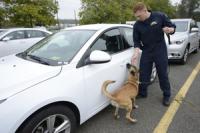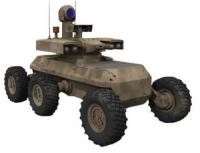-
Knife-crime assault data to help forecast fatal stabbings

Knife crime data from a 12-month period could be used to help forecast the London neighborhoods most likely to suffer a fatal stabbing the following year, according to latest research.
-
-
Studying Perry Mason to combat “innocence fatigue”
Forensic science historian Professor Ian Burney is studying the influence of Erle Stanley Gardner, creator of renowned TV attorney Perry Mason, in a bid to reveal the roots of the fascination with stories about wrongful criminal conviction. Burney hopes the study will help better understand some of the challenges facing today’s worldwide “innocence projects.”
-
-
Israeli air strike destroys Iranian missile production, storage facility in Syria

Satellite images released Sunday by ImageSat International (ISI) showed the impact of an airstrike, blamed on Israel, on a missile base in Syria on Saturday evening that reportedly killed Iranian personnel. Israeli analysts say that recent Israeli air strikes in Syria probably would not have passed without public Russian comment had Israel and Russia not reached an understanding designed to reduce possible friction and improve early warning between Israeli and Russian armed forces operating in Syria.
-
-
As Russia expanded its Arctic Sea presence, U.S. observers see veiled threat

Some U.S. military officials and legislators have expressed concern that Washington isn’t paying enough attention to Russia’s military entrenchment in the region. They say the Department of Defense Arctic Strategy, last updated in 2017, largely got overlooked in the more all-encompassing National Defense Strategy, the main U.S. military strategy document signed by the chairman of the Joint Chiefs of Staff.
-
-
It is safer to be a cop today than 50 years ago

There is no doubt that policing is a dangerous profession. But is it safer to be a cop today than it was fifty years ago? Yes, according to a study that analyzed police officer deaths (felonious and non-felonious) in the United States from 1970 to 2016.
-
-
Detecting, analyzing suspicious activity in surveillance footage

Traditional surveillance cameras do not always detect suspicious activities or objects in a timely manner. Researchers developed a hybrid lightweight tracking algorithm known as Kerman (Kernelized Kalman filter).
-
-
Do armed guards prevent school shootings?
The presence of guns in schools is a fact of life for millions of American children. Forty-three percent of public schools had an armed law enforcement officer during the 2015-2016 school year. Does increasing armed school security could reduce deaths from active shootings or deter the attacks in the first place? Experts say the data is not encouraging. Guns have stopped some mass shootings — but not usually in schools.
-
-
Firearm deaths surges in school-age children
Firearm-related deaths in school-age children are increasing at alarming rates in the United States where homicide rates are about 6- to 9-fold higher than those in comparably developed countries. This epidemic poses increasingly major clinical, public health and policy challenges.
-
-
Crowdsourcing speeds up monitoring of earthquake
Data produced by Internet users can help to speed up the detection of earthquakes. Fast and accurate information is essential in the case of earthquakes: Epicenter location, depth and magnitude are minimum requirements to reliably estimate their possibly catastrophic consequences.
-
-
Polymers help minimize fuel explosions and fires from accidents and terrorist acts
When an act of terrorism or a vehicle or industrial accident ignites fuel, the resulting fire or explosion can be devastating. On Tuesday, scientists described how lengthy but microscopic chains of polymers could be added to fuel to significantly reduce the damage from these terrifying incidents without impacting performance.
-
-
Turning incident scenes into virtual 3D models
When officers arrive at a crime or crash scene, they have to spend a lot of time looking for evidence, processing it, taking photos of it, and documenting. To help make this process more efficient, the Department of Homeland Security’s (DHS) Science and Technology Directorate (S&T) has teamed up with the Israeli Police to invest in a new tool.
-
-
Improving canine detection of explosives

The Department of Homeland Security (DHS) Science and Technology Directorate (S&T) has awarded $564,988 in funding to Auburn University for two research and development (R&D) projects designed to improve the effectiveness and efficiency of canines trained to detect explosives.
-
-
In disasters, Twitter users with large networks get out-tweeted
New study shows that when it comes to sharing emergency information during natural disasters, timing is everything. The study on Twitter use during hurricanes, floods and tornadoes offers potentially life-saving data about how information is disseminated in emergency situations, and by whom. Unlikely heroes often emerge in disasters, and the same is true on social media.
-
-
Killer robots already exist, and they’ve been here a very long time

The question is not so much whether we should use autonomous weapon systems in battle – we already use them, and they take many forms. Rather, we should focus on how we use them, why we use them, and what form – if any – human intervention should take.
-
-
Israel’s Carbyne, RapidSOS partner to improve 911 calls
Dialing 911 in an emergency is something that we’ve all been instructed to do since childhood. And old-fashioned, simple dialing is what most of us are still doing, even in an age of far more sophisticated technology. Next-gen public safety tech company will provide call takers with more informative real-time data to help first responders locate and treat callers.
-
More headlines
The long view
AI-Controlled Fighter Jets May Be Closer Than We Think — and Would Change the Face of Warfare
Could we be on the verge of an era where fighter jets take flight without pilots – and are controlled by artificial intelligence (AI)? US R Adm Michael Donnelly recently said that an upcoming combat jet could be the navy’s last one with a pilot in the cockpit.
What We’ve Learned from Survivors of the Atomic Bombs
Q&A with Dr. Preetha Rajaraman, New Vice Chair for the Radiation Effects Research Foundation in Hiroshima and Nagasaki, Japan.
Need for National Information Clearinghouse for Cybercrime Data, Categorization of Cybercrimes: Report
There is an acute need for the U.S. to address its lack of overall governance and coordination of cybercrime statistics. A new report recommends that relevant federal agencies create or designate a national information clearinghouse to draw information from multiple sources of cybercrime data and establish connections to assist in criminal investigations.
Autonomous Weapon Systems: No Human-in-the-Loop Required, and Other Myths Dispelled
“The United States has a strong policy on autonomy in weapon systems that simultaneously enables their development and deployment and ensures they could be used in an effective manner, meaning the systems work as intended, with the same minimal risk of accidents or errors that all weapon systems have,” Michael Horowitz writes.
Twenty-One Things That Are True in Los Angeles
To understand the dangers inherent in deploying the California National Guard – over the strenuous objections of the California governor – and active-duty Marines to deal with anti-ICE protesters, we should remind ourselves of a few elementary truths, writes Benjamin Wittes. Among these truths: “Not all lawful exercises of authority are wise, prudent, or smart”; “Not all crimes require a federal response”; “Avoiding tragic and unnecessary confrontations is generally desirable”; and “It is thus unwise, imprudent, and stupid to take actions for performative reasons that one might reasonably anticipate would increase the risks of such confrontations.”
Luigi Mangione and the Making of a ‘Terrorist’
Discretion is crucial to the American tradition of criminal law, Jacob Ware and Ania Zolyniak write, noting that “lawmakers enact broader statutes to empower prosecutors to pursue justice while entrusting that they will stay within the confines of their authority and screen out the inevitable “absurd” cases that may arise.” Discretion is also vital to maintaining the legitimacy of the legal system. In the prosecution’s case against Luigi Mangione, they charge, “That discretion was abused.”
